<Back to Index>
- King of Montenegro Nicholas I, 1841
- King of Nepal Gyanendra, 1947
PAGE SPONSOR
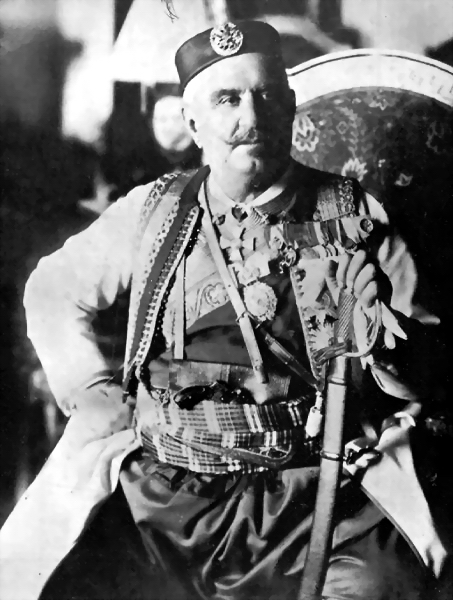
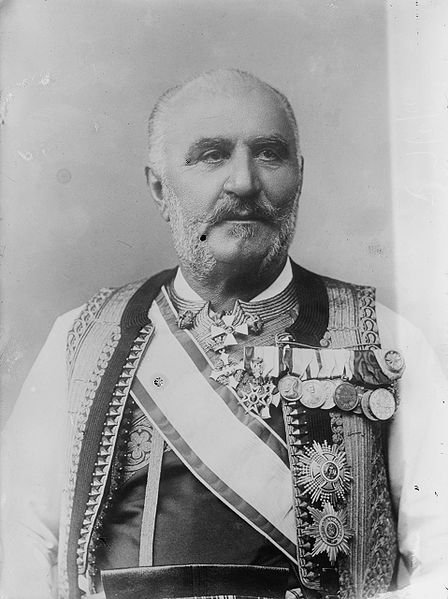
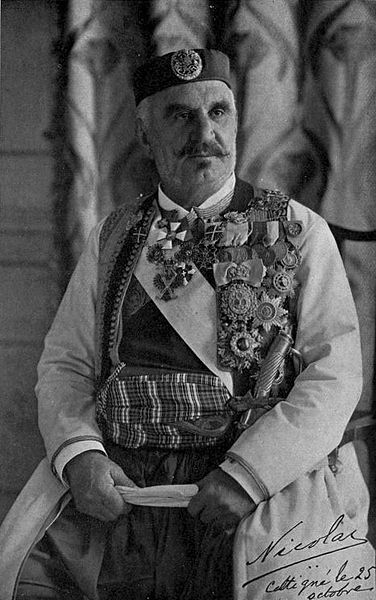
Nikola I Mirkov Petrović - Njegoš (Serbian Cyrillic: Никола I Мирков Петровић - Његош) (October 7 [O.S. September 25] 1841 – March 1, 1921) was the only king of Montenegro, reigning as king from 1910 to 1918 and as prince from 1860 to 1910. He was also a poet, notably penning "Onamo, 'namo!", a popular song from Montenegro.
Nikola was born in the village of Njeguši, the ancient home of the reigning House of Petrović. His father, Mirko Petrović - Njegoš, a celebrated Montenegrin warrior, was elder brother to Danilo I of Montenegro, who left no male offspring. After 1696, when the dignity of Vladika, or prince - bishop, became hereditary in the Petrović family, the sovereign power had descended from uncle to nephew, the Vladikas belonging to the order of the black clergy (i.e., monastic clergy) who are forbidden to marry. A change was introduced by Danilo I, who declined the episcopal office, married and declared the principality hereditary in the direct male line. Mirko Petrović - Njegoš having renounced his claim to the throne, his son was nominated heir presumptive, and the old system of succession was thus accidentally continued.
Prince Nikola, who had been trained from infancy in martial and athletic exercises, spent a portion of his early boyhood at Trieste in
the household of the Kustic family, to which his aunt, the princess
Darinka, wife of Danilo II, belonged. The princess was an ardent francophile, and at her suggestion the young heir presumptive of the viadikas was sent to the Lycée Louis - le - Grand in Paris. Unlike his contemporary, King Milan of Serbia,
Prince Nikola was little influenced in his tastes and habits by his
Parisian education; the young highlander, whose keen patriotism,
capability for leadership and poetic talents early displayed themselves,
showed no inclination for the pleasures of the French capital, and
eagerly looked forward to returning to his native land.
He was still in Paris when, in consequence of the assassination of his uncle Danilo I, he succeeded as prince (August 13, 1860). In November 1860 he married Milena, daughter of the vojvoda Petar Vukotić.
In the period of peace which followed he carried out a series of military, administrative and educational reforms. The country was embroiled in a series of wars with the Ottoman Empire between 1862 and 1878. In 1867 he met the emperor Napoleon III at Paris, and in 1868 he undertook a journey to Russia, where he received an affectionate welcome from the tsar, Alexander II. He afterwards visited the courts of Berlin and Vienna. His efforts to enlist the sympathies of the Russian imperial family were productive of important results for Montenegro; considerable subventions were granted by the tsar and tsaritsa for educational and other purposes, and supplies of arms and ammunition were sent to Cetinje. In 1871 Prince Dolgorukov arrived at Montenegro on a special mission from the tsar, and distributed large sums of money among the people. In 1869 Prince Nikola, whose authority was now firmly established, succeeded in preventing the impetuous highlanders from aiding the Krivosians in their revolt against the Austrian government; similarly in 1897 he checked the martial excitement caused by the outbreak of the Greco - Turkish War.
Follow me Montenegrins - on to Bar, on to our Serb Bar, on to Serb sea!...
In 1876 he declared war against Turkey; his military reputation was enhanced by the ensuing campaign, and still more by that of 1877 - 78, during which he captured Nikšić, Bar and Ulcinj. The war resulted in a considerable extension of the Montenegrin frontier and the acquisition of a seaboard on the Adriatic. He justified the war as a revenge for the Battle of Kosovo in 1389. In 1876 he sent a message to the Montenegrins in Herzegovina:
- Under Murad I the Serbian Tsardom was destroyed, under Murad V it has to rise again. This is my wish and wish of all of us as well as the wish of almighty God.
The independence of Montenegro was recognized at the Congress of Berlin in 1878 and in the succeeding decades Montenegro enjoyed considerable prosperity and stability. Education, communications and the army expanded greatly (the latter with support from Imperial Russia). In 1883 Prince Nikola visited the sultan, with whom he subsequently maintained the most cordial relations; in 1896 he celebrated the bicentenary of the Petrović dynasty, and in the same year he attended the coronation of the Tsar Nicholas II; in May 1898 he visited Queen Victoria at Windsor Castle.
In 1900 he took the style of Royal Highness. He gave Montenegro its first constitution in 1905 following pressure from a population eager for more freedom. He also introduced west European style press freedom and criminal law codes. In 1906, he introduced Montenegrin currency, the perper. On the August 28, 1910, during the celebration of his jubilee, he assumed the title of king, in accordance with a petition from the Skupština. He was at the same time gazetted field marshal in the Russian army, an honor never previously conferred on any foreigner except the Duke of Wellington.
When the Balkan Wars broke
out in 1912 King Nicholas was one of the most enthusiastic of the
allies. He wanted to drive the Ottomans completely out of Europe. He
defied the Powers and captured Scutari despite the fact that they blockaded the whole coast of Montenegro. Again in the Great War which began in 1914 he was the first to go to Serbia's aid to repel the Austrian forces from the Balkan Peninsula. He was personally a huge supporter of Serbdom, and wished for Serb unity. However, he was bitterly opposed to the Karađorđevićs. After the First World War Montenegro united with the other south Slav lands, to form the Kingdom of Serbs, Croats and Slovenes, which was renamed Yugoslavia in 1929.
Nikola went into exile in France 1918, but continued to claim the throne until his death in Antibes three
years later. He was buried in Italy.
In 1989, the remains of Nikola, his queen Milena, and two of their twelve children were re-buried in Montenegro.
Five of his daughters were married, each to princes and kings, giving Nikola the nickname "the father - in - law of Europe", a sobriquet he shared with the contemporary King of Denmark.
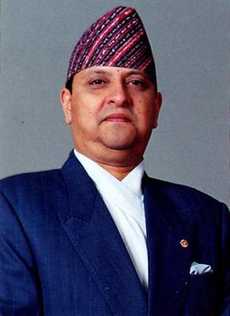
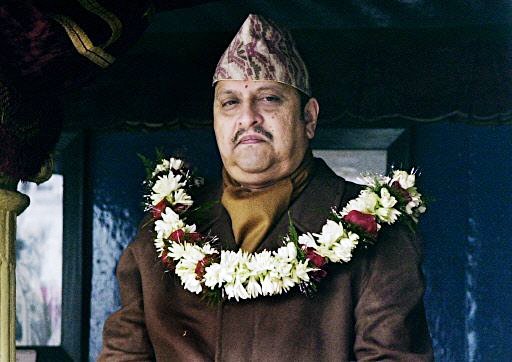
Gyanendra Shah (Nepali: ज्ञानेन्द्र वीर बिक्रम शाह; Jñānendra Vīra Bikrama Śāh) (born 7 July 1947) was the last King of Nepal. During his life, he has held the title of the King twice: first between 1950 and 1951 as a child when his grandfather Tribhuvan was forced into exile in India with the rest of his family; and from 2001 to 2008, following the Nepalese royal massacre.
King Gyanendra's second reign ended in 2008, when the monarchy was abolished and the interim Federal Republic of Nepal formed in its place. Gyanendra became a private citizen and was stripped of his royal status.
Unable to hold the election on time, the then Prime Minister of Nepal Sher Bahadur Deuba,
repeatedly asked for continuances with the King. Citing the failure of
the Prime Minister to hold the election, King Gyanendra sacked the
cabinet and assumed power and formed a new government. In February 2005,
King Gyanendra took complete control of the government, dismissing the
elected parliament (Parliament was dismissed in 2002 when King Gyanendra
sacked the government of PM Sher Bahadur Deuba). He gave assurances
that the country would return to normalcy and prosperity in three years. Following opposition to his direct rule he
was forced to return power to the parliament in April 2006, which in
turn reduced the King's status to that of a ceremonial monarch. He
continued as such until 28 May 2008 when the Constituent Assembly
controlled by the Maoists decided to depose him and declared Nepal an
interim republic until a republican constitution was promulgated. The
constitution drafting deadline expired on May 28, 2010 with no new
constitution in place. There had been some calls from parties loyal to
the monarchy for a referendum to decide on the need for a monarchy after
the constitutional crisis brought about the resignation of the
Maoist led government.
Gyanendra was born in Narayanhity Royal Palace, Kathmandu, as the second son of Crown Prince Mahendra and his wife Crown Princess Indra. After his birth, his father was told by a court astrologer not to look at his newborn son because it would bring him bad luck, so Gyanendra was sent to live with his grandmother.
In November 1950, during a political plot, both his father and his grandfather King Tribhuvan, along with other royals, fled to India, leaving the young Prince Gyanendra as the only male member of the royal family in Nepal. He was brought back to the capital Kathmandu by the Prime Minister Mohan Shamsher, who had him declared King on 7 November 1950. Gyanendra was not only crowned but coins were issued in his name. The Rana Prime Minister provided a three hundred thousand rupee annual budget as expenditure for the King. After opposition to the hereditary rule of the Rana Prime Ministers from India, a deal was reached in January 1951, and his grandfather King Tribhuvan returned to Nepal and resumed the throne. The actions of the Rana regime to depose his grandfather and place Gyanendra on the throne was not internationally recognized.
He studied with his elder brother King Birendra in St. Joseph's College, Darjeeling, India; in 1969, he graduated from Tribhuvan University, Kathmandu.
Prince Gyanendra served as the chairman of the Advisory Committee for the Coronation of his brother King Birendra in 1975. He is a keen conservationist and served as Chairman of the King Mahendra Trust for Nature Conservation (later known as National Trust for Nature Conservation) from 1982 until his ascension to the throne in 2001.
Gyanendra married Komal Rajya Laxmi Devi Shah on 1 May 1970 in Kathmandu. They have two children.
- Prince Paras Shah of Nepal (born 30 December 1971)
- Princess Prerana Singh of Nepal (born 20 February 1978).
During his early years on the throne, King Gyanendra sought to exercise full control over the government because of the failure of all parties. In May 2002, he supported the popularly elected Prime Minister Sher Bahadur Deuba when he dismissed the parliament elected in 1999. In October 2002, he dismissed Deuba and consolidated his power for the first time. During the years 2002 to 2005 he chose and subsequently dismissed three prime ministers, finally dismissing Deuba for the second time and taking over as absolute ruler on 1 February 2005. His brother King Birendra had negotiated a constitutional monarchy during his rule in a delicate manner in which he, as King, played a minor role in government. Thus, King Gyanendra's confrontational approach with the established political parties was met with widespread censure.
When King Gyanendra took complete control for the second time, on 1 February 2005, he accused Prime Minister Sher Bahadur Deuba's government of failing to make arrangements for parliamentary elections and of being unable to restore peace in the country, then in the midst of a civil war led by Maoist insurgents.
King Gyanendra promised that "peace and effective democracy" would be restored within three years, but the period of direct rule was accompanied by repression of dissent. International organizations expressed grave concerns about the safety of journalists, following the king's decision to restrict civil liberties, including freedom of the press, the constitutional protection against censorship and the right against preventive detention. Gyanendra countered, saying that "democracy and progress contradict one another" as a necessary step in restoring peace to the country.
In April 2006, the Maoists and Sister Organizations staged protests and strikes in Kathmandu
against
King Gyanendra's direct rule. The royal government exercised minimum
restraint but responded by declaring a curfew to control the
deteriorating situation, which was enforced with live firearms and tear
gas. On 21 April 2006, King Gyanendra announced that he would yield
executive authority to a new prime minister chosen by the political
parties to oversee the return of democracy. Several party leaders
rejected the offer and again demanded that the King call a council to
determine the monarchy's future role in politics. An agreement was
reached between the parties, King under the supervision of Indian ruling
Congress including Dr. Karan Singh that monarchy would have a place in
the new constitution. Girija Prasad Koirala was
appointed prime minister in the interim. Girija Prasad, as the main
leader, had talks with the King and the agreement for monarchy's space.
As such, on 24 April 2006, King Gyanendra reinstated the previous
parliament in a televised address to the nation.
Mysteriously, the agreement between the parties and King under Indian supervision was not honored by the parties. It is widely believed that the then Prime Minister Girija Prasad saw an opportunity to become the first president of Nepal by declaring Nepal a republic state. On 10 June 2006, the Parliament scrapped the major powers of the King, including his right to veto laws. This ended the idea of a "King in Parliament", and he was reduced to a figurehead, though for a time he continued to offer felicitations and to receive diplomats. According to Article 167 of the constitution, all executive powers as well as those enjoyed by the King in the previous Constitution were now vested in the prime minister. All powers of the 239 year old monarchy were stripped, making King Gyanendra a civilian king.
Prime Minister Girija Prasad Koirala, who previously supported the continuation of the monarchy, said in March, 2007 that he thought the King should step down. In June, Koirala repeated his call for King Gyanendra to abdicate in favor of his grandson Prince Hridayendra.
On
23 August 2007, Nepal's transitional government nationalized all the
properties King Gyanendra inherited from his brother including the Narayanhity Royal Palace. The move did not affect the properties he owned before his ascension to the throne.
King Gyanendra, in an interview with foreign reporters, expressed dissatisfaction over the decision made by the interim parliament to abolish the monarchy after the 10 April Constituent Assembly elections. The interview was published in Japan's leading newspaper, Daily Yomiuri. Speaking to a select group of Japanese correspondents at the Narayanhiti Royal Palace on 4 February, King Gyanendra said, "(The decision) doesn't reflect the majority view of the people. This isn't democracy." He, however, conceded that the people do have the right to choose the fate of the monarchy.
The King also said the law and order in the country was deteriorating, questioning the interim government's ability to govern the country even after he had accepted the roadmap of the seven party alliance. Citing the recent survey which showed 49 percent of respondents favored the continuation of the monarchy in some form, King Gyanendra claimed, "A majority of the people find great meaning in the institution of the monarchy. In all clouds, there is a silver lining. Let us hope."
Gyanendra had broken his closely guarded silence in an interview with a Nepali pro-monarchist weekly paper in which he said he remained silent to "let the peace process succeed." The King said, "Nepalese people themselves should speak out on where the nation is heading, on the direction it is taking and on why it is becoming chaotic." He claimed that his attempt on 1 February 2005 was for a good purpose — restoring peace and stability in the country. He said that his attempt was not a success and so the countrymen are suffering at present.
In an interview taken with the King’s ‘advisor’, Bharat Keshar Singh, he claimed that the bill passed from the parliament was a bluff. Replying to the question raised regarding the King’s silence even after the bill was passed declaring the state a republic, he said that there was nothing for which the King had to respond. He claimed that the parliament which declared a republic was reinstated by the King himself and has no authority to dethrone the same King. He claimed that the King was examining the activities of the government and the parliament and was waiting for a suitable time for responding to them. He said that no people would accept the ‘bill’ unless decided by a referendum or elected members in the constituent assembly.
On
15 January 2007, the interim parliament was set up with CPN-M included,
and on 1 April 2007, the interim government joined by CPN-M was formed.
On 28 December 2007, the Nepali interim parliament approved a bill for
the amendment to the constitution of 1990 promulgated on 15 January
2007, with a clause stating that Nepal will turn into a federal
democratic republic, to be implemented by the first meeting of the
Constituent Assembly elections.
It was announced on 24 December 2007, that the monarchy would probably be suspended in 2008, following the approval, as part of a peace deal with Maoist rebels, of the Nepalese Parliament in favor of a bill that would see the constitution amended so as to make Nepal a republic.
On 27 May 2008, the meeting decided to give the King fifteen days to vacate the palace, and decided that the first meeting would be held the next day at 11am (but was delayed due to the indecision among the leading parties on power sharing and the nomination of 26 members of the Constituent Assembly).
On 28 May 2008, the monarchy was officially given no space in the amended constitution of 1990 and replaced with a republic by the Constituent Assembly instead of referendum. King Gyanendra accepted the decision in the following days. As he was required to leave Narayanhiti, he asked the government to make residential arrangements for him on 1 June, and on 4 June the government decided to give Nagarjuna Palace to Gyanendra.
King Gyanendra departed the Narayanhiti Palace in Kathmandu on 11 June 2008, moving into the Nagarjuna Palace. His new residence consists of ten buildings including the royal residence Hemanta Bas, three guest houses (Barsha Bas, Sharad Bas and Grishma Bas), one office secretariat and one staff quarters. Gyanendra and his family moved into the two storey Hemanta Bas. Following his departure the Narayanhiti Palace was turned into a museum, while Gyanendra's diamond- and ruby - encrusted Crown and royal scepter, along with all the other crown jewels and royal assets, became government property. The royal family's departure from the palace was reported as being a “major symbolic moment in the fall of the Shah dynasty, which had unified Nepal in the 1760s.”